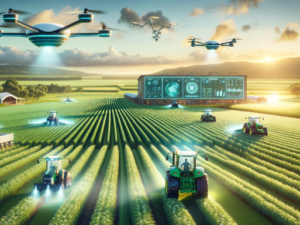
The agricultural sector has long been a cornerstone of human civilization, but it faces significant challenges such as climate change, population growth, and the need for sustainable practices. The Internet of Things (IoT) is revolutionizing farming practices through precision agriculture, enhancing efficiency, productivity, and sustainability. By leveraging IoT technology, farmers can make informed decisions based on real-time data, leading to better resource management and increased crop yields.
Iot in agriculture
Precision Agriculture: A New Era in Farming
Precision agriculture is an innovative farming approach that utilizes IoT devices and sensors to monitor and manage agricultural practices in real time. By collecting data on various environmental factors, farmers can optimize their operations, reduce waste, and improve crop health. Here are some key areas where IoT is making a significant impact:
1. Soil Moisture Monitoring
One of the most critical factors affecting crop growth is soil moisture. Traditional methods of assessing soil moisture can be labor-intensive and often rely on guesswork. IoT sensors, such as capacitive soil moisture sensors and tensiometers, have transformed this process.
- Capacitive Soil Moisture Sensors: These sensors measure the volumetric water content in the soil by detecting the dielectric constant, providing real-time data on soil moisture levels. For example, CropX offers a solution that enables farmers to monitor soil moisture, allowing them to irrigate only when necessary, thus conserving water and reducing costs.
- Tensiometers: These devices measure the tension or suction of water in the soil, helping farmers understand when their crops need water. Companies like Irrometer produce tensiometers that can be integrated with IoT platforms to provide continuous data and alerts for irrigation management.
2. Weather Prediction
Weather plays a vital role in agriculture, affecting everything from planting to harvesting. IoT technology helps farmers stay ahead of unpredictable weather patterns through advanced weather prediction systems.
- Weather Stations: IoT-enabled weather stations collect data on temperature, humidity, wind speed, and precipitation levels. These stations, such as those from Davis Instruments, can transmit real-time weather data to farmers, allowing them to make timely decisions regarding irrigation, planting, and pest control.
- Microclimate Monitoring: By deploying IoT sensors across different areas of a farm, farmers can create detailed microclimate maps that inform them about localized weather variations. For instance, Agrilyst provides a platform that integrates weather data with greenhouse management, helping growers optimize conditions for plant growth.
3. Livestock Tracking and Management
IoT technology is also revolutionizing livestock management by enabling farmers to monitor the health and well-being of their animals.
- Wearable Sensors: Livestock can be equipped with IoT-enabled collars or ear tags that monitor their location, health, and behavior. For example, Allflex offers smart livestock tags that track movement, feeding habits, and vital signs, alerting farmers to any unusual behavior that may indicate health issues.
- Precision Feeding: IoT sensors can be used to monitor feed consumption and optimize nutrition based on individual animal needs. Companies like FeedWatch provide solutions that help farmers track and analyze feed data, improving livestock health and productivity.
4. Irrigation Management
Efficient irrigation is essential for maximizing crop yields while conserving water. IoT technology allows for smart irrigation systems that adapt to real-time data.
- Smart Irrigation Systems: By integrating soil moisture data with weather forecasts, farmers can automate irrigation schedules to optimize water usage. For instance, RainMachine offers a smart irrigation controller that connects to local weather data and soil moisture sensors to adjust watering schedules accordingly.
- Drip Irrigation Monitoring: IoT sensors can monitor the performance of drip irrigation systems, ensuring that water is delivered precisely where and when it is needed. Companies like Netafim provide IoT solutions that help farmers manage irrigation more effectively, resulting in reduced water waste and improved crop health.
Conclusion
IoT technology is fundamentally changing the landscape of agriculture, empowering farmers to adopt precision agriculture practices that enhance productivity and sustainability. By leveraging IoT sensors for soil moisture monitoring, weather prediction, and livestock tracking, farmers can make informed decisions that optimize resource use and improve crop yields. As IoT continues to evolve, its potential to transform agriculture into a more efficient and sustainable industry will only grow, ensuring food security for future generations while minimizing environmental impact. The integration of these technologies not only benefits farmers but also contributes to a more sustainable agricultural ecosystem, addressing some of the pressing challenges faced by the industry today.
visit: gamicaltech.com iot in agriculture iot in agriculture iot in agriculture iot in agriculture iot in agriculture iot in agriculture